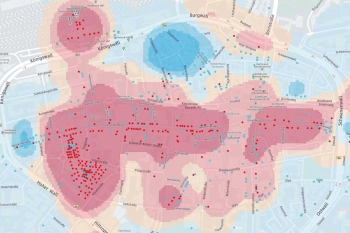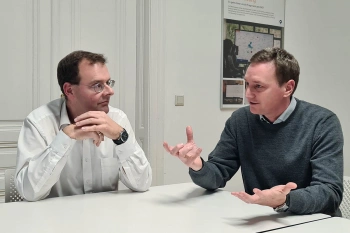Geo AI: Expert Interview on Artificial Intelligence in Geoanalytics
WIGeoGIS Expert Interview on Geo AI
Geo AI describes the use of artificial intelligence within geoanalytics or geoinformatics. University Professor Johannes Scholz devotes his research to this topic and has already led and carried out numerous research projects, including projects in cooperation with WIGeoGIS.
In the expert interview with WIGeoGIS, he sheds light on, among other things, the following questions:
- In which application areas is Geo AI already achieving good results?
- What are the biggest hurdles for Geo AI?
- Where is there a need for research in Geo AI?
Relevant Questions about GIS and Artificial Intelligence
- In your opinion, how big is the potential for artificial intelligence in geoanalytics (Geo AI)?
- Where is Geo AI helpful today, in 2025?
- Can you share some examples from your research on Geo AI?
- How exactly do you work with Geo AI?
- What is the difference between ChatGPT and Geo AI models?
- How does data have to be prepared for Geo AI models?
- Where do you see the biggest challenges in training Geo AI models?
- How well are we already able to predict human behavior?
- To what extent can the results of Geo AI be trusted?
- How well can AI recognize patterns in unstructured mass data?
- What stage of development is Geo AI currently?

Professional Profile
Univ.-Prof. Dipl.-Ing. Dr. Johannes Scholz is a full professor of geoinformatics at the Institute of Geoinformatics (Z_GIS) at the Paris-Lodron University of Salzburg. There he leads the group “GeoAI, GeoKG, and GeoSemantics”. At Z_GIS, both basic and applied research are conducted.
Previously, Scholz was, among other things, an associate professor at the Graz University of Technology (Institute of Geodesy, Geoinformation Research Group), a member of the Geographic Information Science Commission of the Austrian Academy of Sciences, a visiting scientist at the Institute of Geography at the University of California, Santa Barbara, and an associate lecturer at the Doctoral College GIScience at the University of Salzburg.
In your opinion, how big is the potential for artificial intelligence in geoanalytics (Geo AI)?
Geo AI plays a role in every area of geoanalytics. It is a very large field of research, but we do not yet know exactly where it will bring real advantages over classical spatial analyses. It is still too early to say whether Geo AI has the potential to revolutionize Geomarketing tools.
If you would like to learn more about Artificial Intelligence in Geoanalytics, simply contact us and we will be happy to answer all your questions!
Where is Geo AI helpful today, in 2025?
You can already do a lot with Geo AI models today, especially in the area of evaluating geodata and identifying trends and relationships in data, provided you have well-trained models. However, we very often see in projects that there is a lack of sufficiently high-quality training and verification data.
Can you share some examples from your research on Geo AI?
In the recently completed project "ABM4EnergyTransition", we aimed to find out which criteria homeowners use to decide on their heating system or the thermal insulation of their private homes. For this purpose, a large survey of 30,000 households was conducted, but we also incorporated classic sociodemographic data provided to us by WIGeoGIS into the AI model. Artificial intelligence was a great help in this project in finding out how, among other things, the financial situation, educational status, and public funding influence homeowners' decisions.
In another research project, we want to use Geo AI together with TU Graz to find out how factors such as climate change, socio-demographic change, and mobility behavior will influence the stability of power grids until 2030.
Curious? We are happy to provide consultation on Artificial Intelligence in Geoanalytics!
How exactly do you work with Geo AI?
In the example mentioned, we want to use highly precise smart meter data, i.e., electricity consumption data and electricity generation data, which are aggregated, i.e. summarized, so that data protection is guaranteed. This means that the data does not reveal which household turns on the television and starts cooking at exactly what time. We also incorporate sociodemographic data and data from a mobile phone provider into the AI model, which tells us something about commuter behavior, for example. We try to process and overlay all of this data in such a way that the AI model tells us something about the future utilization of the power grid. A research question is at which level we can make predictions, for example, at the neighborhood level or the building block level, although there will always be uncertainties.
What is the difference between ChatGPT and Geo AI models?
Geo AI always deals with questions with a geographical reference. Moreover, large language models, such as ChatGPT 4.0, are aimed at end consumers and are trained using a dataset that is available at a specific point in time. Users interact with the model via prompts. We, on the other hand, train our own AI models. This means we first have to prepare the data we receive, and that is not as easy as it sounds.
Do you want to learn about the possibilities of GIS and AI?
How does data have to be prepared for Geo AI models?
Raw data alone does not constitute an AI model. It must be prepared, trained, and structured according to the question at hand, for example, assigned to different categories. Only then can an algorithm recognize and process relationships between the data. In technical terms, we call this preparation feature engineering. This step is often very time-consuming, takes days and weeks, and involves a lot of trial and error. The analysts have to play around and experiment a lot to create a working AI model. Feature engineering currently can not be performed by AI models themselves.

Where do you see the biggest challenges in training Geo AI models?
One of the biggest challenges is data availability, where we need not only a certain quantity of training data, but also the highest possible quality. AI models learn similarly to children: The more often they come into contact with something, the better and faster they can recognize patterns: "Ah, that scratches, I know that, that must be a cat. Oh, it is barking, so it must be a dog." The more dogs and cats a child sees, the more likely they are to memorize the patterns and distinguish them better. Only once the algorithm has seen enough, can it also recognize patterns and assign categories using statistical probabilities.
In geomarketing, we often try to predict human behavior. How well are we already able to do this today?
This is a very big challenge that we have been dealing with for several years. For example, in one project we modeled tourism flows in Salzburg. It is important to have a variety of different data available in order to recognize people's movement patterns. This means that we incorporate as many decision-making levels as possible. For such tasks, we like to work with hybrid models, specifically a combination of agent-based modeling, which involves simulation, and the detection of neighborhood effects, and artificial intelligence. AI can uncover patterns within the data that would be difficult or even impossible for a human to detect.
Get the most out of Geoanalytics and Geo AI
To what extent can the results of Geo AI be trusted, especially considering that the same question does not always produce the same result?
That is true, although even an agent-based AI model or ChatGPT does not necessarily deliver the same result for real-time queries. The same is true for Geo AI: The overall trends will be similar, but the details may vary. For example, when searching for a location, artificial intelligence might consistently display a location within a certain region or grid cell, but the specific location could vary each time. To ensure explainability, it is important to clearly communicate to users and customers the level of detail at which the AI can deliver insights, for example at the building level, neighborhood level, etc. Sometimes the source data is not that granular and you need to choose a higher aggregation level.
How well can AI recognize patterns in unstructured mass data?
Artificial intelligence is already very good at extracting patterns, features and trends from unstructured data and structuring them, thus making knowledge explicit. AI models, like deep learning, provide us with excellent opportunities to turn unstructured data into partially structured or fully structured data and, if necessary, to georeference it, i.e., to assign a location to the data. For example, in a project with the Austrian Armed Forces, we analyzed unstructured media data with Geo AI and were able to identify and geographically locate disaster areas based on the content of media reports. This solution worked quite well.
In your opinion, in what stage of development is Geo AI currently?
We need to make distinctions here. The field of Earth Observation within geoinformatics, for example, is already highly advanced. There are already many standardized image analysis methods that work extremely well. For instance, a colleague at TU Graz successfully developed an AI system that automatically determines whether roofs are equipped with thermal solar panels or photovoltaic modules. In contrast, when it comes to human behavior, for example, when creating movement analyses and forecasts, further development is still needed. While good progress is currently being made in this area, there are still no standardized methods. Especially in Europe, compared to the USA, China, and Korea, we still need significantly more research initiatives.
For more information on Artificial Intelligence and further expert interviews:

Location Analysis with Artificial Intelligence
Three years of development went into WIGeo Location Atlas, taking location analysis to a new level. With this new product, you can find the most attractive areas for your location more quickly than ever before.

Artificial Intelligence and GIS
Artificial Intelligence in geomarketing gets even more out of location analyses and sales forecasts, now and in the future. Find out more in this WIGeoGIS expert interview.

Integrating Internal Geodata in GIS
WIGeoGIS experts Andreas Marth and Michael Steigemann answer questions about data integration in GIS in the following interview. You gain transparency and get the added value from your data.

An Interview with Geodata Experts
WIGeoGIS experts Norbert Hackner-Jaklin and Martin Ortner answer current questions about geodata. What is the benefit of combining geodata with company data?
GIS, Geoanalytics and Geo AI: Request a free initial consultation
- FREE initial consultation on GIS, Geoanalytics and Geo AI
- Non-binding, without further obligations
- By telephone or video call
Do you want to know more about GIS, Geoanalytics and Geo AI? I will gladly support you. Please contact me!

